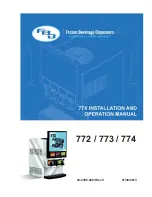
To remove a clip:
1 .
Turn off water and release water pressure at the valve.
2 .
Push the water line connectors into the bypass and valve.
This will help release O-rings that may have seated in
place .
3 .
Remove the clip by inserting a flat blade under the top
center of the clip and lifting (prying up).
CAUTION
Do not use pliers to remove a clip. It is likely the
clip will break.
NOTE: Before turning on the water to the valve, rotate the
two handles on the bypass valve 2-3 times. This
will help seat O-rings and prevent leaking.
Drain Line Flow Control
The drain line flow control (DLFC) 1/2" NPT requires assembly
(Figure 11).
1 .
Locate parts and a roll of Teflon tape (not included).
2 .
Wrap the tape over threads of the flow control.
3 .
Screw the flow control and a proper size drain fitting
together . Hand tighten .
4 .
Place the ball into the flow control and insert the assembly
into the drain line opening .
5 .
Push the assembly in and secure with the drain line clip.
Drain Line
Fitting
Flow Control
Control Ball
Drain Line Clip
Figure 11
Drain Line Connection
NOTE: Standard commercial practices are expressed here.
Local codes may require changes to the following
suggestions. Check with local authorities before
installing a system.
1 .
The unit should be above and not more than 20 feet
(6.1 m) from the drain. Use an appropriate adapter fitting
with a hose clamp to connect 1/2-inch (1.3 cm) plastic
tubing to the drain line connection of the control valve.
2 .
If the backwash flow rate exceeds 5 gpm (22.7 Lpm) or if
the unit is located 20-40 feet (6.1-12.2 m) from drain, use
3/4-inch (1.9 cm) tubing. Use appropriate fittings to connect
the 3/4-inch tubing to the 3/4-inch NPT drain connection on
the valve.
3 .
The drain line may be elevated up to 6 feet (1.8 m)
providing the run does not exceed 15 feet (4.6 m) and
water pressure at the softener is not less than 40 psi
(2.76 bar). Elevation can increase by 2 feet (61 cm) for
each additional 10 psi (.69 bar) of water pressure at the
drain connector .
4 .
Where the drain line is elevated but empties into a drain
below the level of the control valve, form a 7-inch (18-cm)
loop at the far end of the line so that the bottom of the loop
is level with the drain line connection. This will provide an
adequate siphon trap .
Where the drain empties into an overhead sewer line, a sink-
type trap must be used.
Secure the end of the drain line to prevent it from moving.
Right Way
Figure 12 Drain Line Connection
NOTE:
Waste connections or drain outlet shall be
designed and constructed to provide for
connection to the sanitary waste system through
an air-gap of 2 pipe diameters or
1 inch (22 mm) whichever is larger.
WARNING:
Never insert drain line directly into a
drain, sewer line, or trap (Figure 12 Drain
Line Connection). Always allow an air gap
between the drain line and the wastewater
to prevent the possibility of sewage being
back-siphoned into the softener.
Overflow Line Connection
In the event of a malfunction, the salt TANK OVERFLOW will
direct “overflow” to the drain instead of spilling on the floor. This
fitting should be on the side of the cabinet.
Attach length of 1/2-inch (1.3-cm) I.D. tubing (not supplied) to
fitting and run to drain. Do not elevate overflow line higher than
overflow fitting (Figure 13 Overflow Line Connection).
Do not tie into drain line of control unit. Overflow line must be a
direct, separate line from overflow fitting to drain, sewer or tub.
Allow an air gap as per drain line instructions .
Figure 13
Overflow Line Connection
EQUIPMENT INSTALLATION
continued
8 • DE11 OM26KCS, OM32KCS, OM36KCS









































